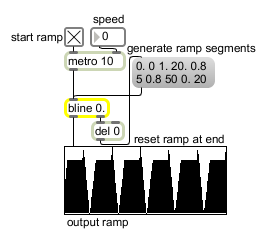| bang |
|
Sends a new step in the breakpoint list out the left outlet. If the current list of ramp segments is finished, a bang message will be sent out the right outlet |
| int |
set-input [int]
|
Sets the bline object to the specified integer value. Any and all pending breakpoint segments are forgotten (i.e. the time is considered 0 and bline outputs the target value when it receives a bang). |
| float |
set-input [float]
|
Sets the bline object to the specified float value. Any and all pending breakpoint segments are forgotten (i.e. the time is considered 0 and bline outputs the target value when it receives a bang). |
| list |
pairs of numbers [list]
|
The bline object sets breakpoint segment values using lists of data composed of pairs of numbers. The first number in each pair can be either an int or a float specifying a target value, followed by an integer that specifies the number of bang messages that will have to be received before reaching the target value--note that this differs from other Max/MSP breakpoint objects like line, which specify a time-to-target value in milliseconds. |
| set |
set-input [int or float]
|
Sets the bline object to the specified value. Any and all pending breakpoint segments are forgotten (i.e. the time is considered 0 and bline outputs the target value when it receives a bang). |
| stop |
|
Stops bline from sending out numbers, until a new list of ramp segments is received. |

